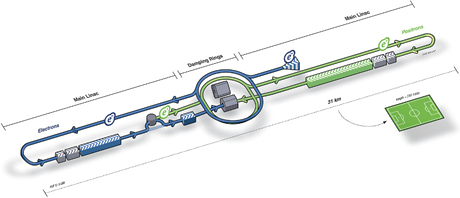Linear collider gains key insights from Cornell physicists
By Anne Ju

The International Linear Collider (ILC), a global effort to build a particle accelerator that may unlock some of the universe’s deepest mysteries, has received pivotal insights from Cornell physicists: They have designed a key component of the proposed collider, called a damping ring, without which the ILC’s powerful particle collisions wouldn’t be possible.
Last month, the ILC’s globally coordinated Technical Design Report – the master document that outlines how to build the ILC – was officially completed and handed over to the International Committee for Future Accelerators (ICFA), the organization that commissioned the study.
The document reflects the culmination of an ongoing project started at Cornell in 2008 that has reconfigured CESR (Cornell Electron Storage Ring), the electron-positron colliding beam machine at Wilson Synchrotron Laboratory, as an ILC test bed.
The National Science Foundation-funded project is called Cornell Electron Storage Ring Test Accelerator (CesrTA). Principal investigator David Rubin, professor of physics, has led the effort to leverage the uniquely flexible design of Cornell’s synchrotron to turn it into a prototype ILC damping ring.
The ILC’s purpose is to make billions of electrons and their antiparticles, called positrons, collide with each other in a fiery ball at the speed of light. The collisions would recreate conditions during the big bang and possibly answer questions of how the universe began.
The ILC would be a complementary machine to the Large Hadron Collider in Switzerland, a proton-proton collider that recently made international headlines by identifying the mass of the “God particle” – the Higgs boson. Plans for the ILC include a “Higgs factory” to study the properties of that recently discovered particle.
Before the electrons and positrons collide in the accelerator, they have to first be cooled, focused and tightly packed in a beam. That happens in a damping ring, a circular accelerator that accepts hot bunches of positrons or electrons, and prepares the beams for acceleration and eventual collision at the end of a 9-mile straightaway.
“What we needed to do is make the beam cool, make it compact so all the positrons are going in the same direction, and focus them down to a very tiny spot, where they will then collide with similarly focused electrons,” Rubin said.
The CesrTA project, in collaboration with an international Damping Ring Working Group, designed the ILC damping ring with magnets called wigglers that wiggle the beam back and forth to emit synchrotron radiation, which cools the beam.
However, the positrons and the synchrotron radiation present a formidable challenge: a phenomenon called the electron cloud, which is extra electrons emitted from the beam pipe vacuum chamber. The electrons can ruin the quality of the beam, which is measured in terms of “emittance,” by interacting with the positrons and causing instabilities.
The CesrTA researchers developed instruments to measure the electron cloud and ran experiments on different kinds of vacuum chamber coatings and geometries to minimize the electron cloud effect and present the best damping ring design to the IFCA.
CESR was a good fit for the ILC damping ring test bed because Cornell high- energy physicists had previously made superconducting wigglers similar to the damping wigglers needed for the ILC, Rubin said. Also, CESR is one of the few electron storage rings in the world that makes positrons; most synchrotron light sources use only electrons. Finally, CESR is flexibly designed to do science of all types, Rubin said, and Cornell has a long tradition of accommodating multidisciplinary enterprises. The CesrTA program shares the accelerator infrastructure at Wilson Lab with the Cornell High Energy Synchrotron Source X-ray facility.
CesrTA is continuing to collect data on how particles in low-emittance beams interact with their environment and each other.
Media Contact
Get Cornell news delivered right to your inbox.
Subscribe